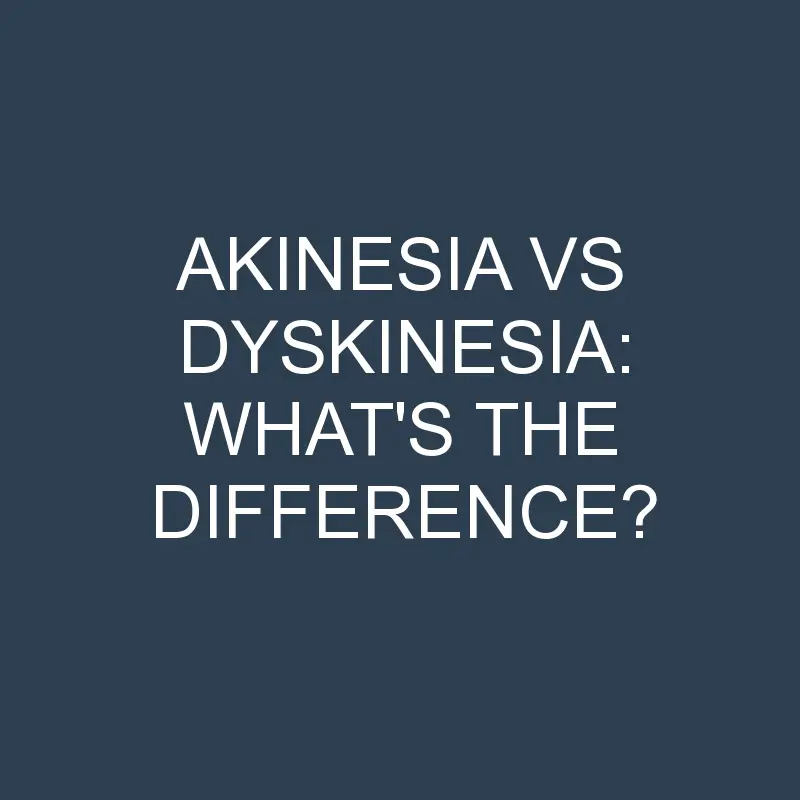Post Contents
Akinesia Vs Dyskinesia: What’s the Difference?
Many people with Parkinson’s disease experience problems with their movement. This can manifest as either akinesia or dyskinesia. Akinesia refers to a decrease in movement, while dyskinesia refers to abnormal or involuntary movements. In this article, we’ll explore the differences between these two types of movement disorders.
What is Akinesia?
Akinesia is a medical term used to describe a loss or decrease in motor skills. It can be caused by a number of different medical conditions, including Parkinson’s disease, stroke, and cerebral palsy. Akinesia can also be a side effect of certain medications. Symptoms of akinesia can range from mild to severe and can include difficulty speaking, moving, or swallowing. Akinesia can be a temporary or permanent condition. There is no cure for akinesia, but treatments are available to help manage the symptoms.
What Is Dyskinesia?
Dyskinesia is a condition that results in involuntary, often jerky movements of the body. The movements may be purposeless and random, or they may be repetitive and follow a pattern. Dyskinesia can affect any part of the body but is most commonly seen in the face, neck, trunk, and limbs.
Dyskinesia can be caused by many different conditions, including certain medications, genetic disorders, brain injury, and stroke. In many cases, the exact cause of dyskinesia is unknown.
Dyskinesia can range from mild to severe. In mild cases, the movements may be barely noticeable and do not interfere with daily activities. In severe cases, the movements can be disabling and make it difficult to perform basic tasks such as walking or eating.
There is no cure for dyskinesia, but there are treatments that can help lessen the symptoms. Medications such as botulinum toxin injections and dopaminergic drugs may be helpful in some cases. Physical therapy and occupational therapy can also help improve the quality of life for people with dyskinesia.
The Difference Between Akinesia and Dyskinesia
There are two types of movement disorders that can occur in people with Parkinson’s disease: akinesia and dyskinesia. Akinesia is a lack of movement, while dyskinesia is uncontrolled or abnormal movement.
People with akinesia may have difficulty starting movements, and their movements may be slower than normal. Dyskinesia can cause jerky, uncontrollable movements, or twitching.
It’s important to know the difference between akinesia and dyskinesia because the treatments for these two types of movement disorders are different.
Akinesia is treated with medication that increases dopamine levels in the brain, while dyskinesia is treated with medication that decreases dopamine levels.
If you have Parkinson’s disease and are experiencing either akinesia or dyskinesia, talk to your doctor about the best treatment options for you.
Akinesia Symptoms
Akinesia is a symptom of several neurological disorders, characterized by a loss of muscle movement or paralysis. The word comes from the Greek “akinesis”, meaning “without movement”.
Akinesia can be caused by damage to the motor cortex, basal ganglia, or other parts of the brain. It can also be caused by medications, such as antipsychotics. Akinesia can be partial or complete.
Symptoms of akinesia include:
* Loss of muscle movement
* Paralysis
* Difficulty speaking
* Difficulty swallowing
* Difficulty breathing
Dyskinesia Symptoms
Dyskinesia is a movement disorder that can cause abnormal or involuntary movements. The most common type of dyskinesia is chorea, which results in jerky, purposeless movements. Other types of dyskinesia include dystonia, myoclonus, and tics.
Dyskinesia can be caused by many different things, including certain medical conditions, medications, and genetic disorders. In some cases, the exact cause of dyskinesia is unknown.
Dyskinesia can be mild or severe. It may go away on its own or may require treatment. Treatment for dyskinesia may include medications, physical therapy, and surgery.
Akinesia Treatment
There are a few different ways to treat akinesia, depending on the underlying cause. If it’s due to Parkinson’s disease, medications like levodopa can be effective. If it’s caused by a stroke, physical therapy may help. In some cases, electrical stimulation of the brain may be an option.
Dyskinesia Treatment
Dyskinesia is a condition characterized by involuntary, often exaggerated, movements. It can be caused by a variety of things, including certain medical conditions, medications, and alcohol or drug abuse. Treatment for dyskinesia typically involves medications to help control involuntary movements. In some cases, surgery may be necessary to correct the underlying cause of dyskinesia.
Conclusion
In conclusion, akinesia and dyskinesia are both movement disorders that can have a significant impact on a person’s quality of life. Akinesia is characterized by a lack of movement, while dyskinesia is characterized by abnormal or involuntary movements.
While there is no cure for either condition, there are treatments available that can help to improve symptoms and manage the condition. If you think you may be suffering from either akinesia or dyskinesia, it is important to speak to your doctor so that you can receive an accurate diagnosis and commence appropriate treatment.
